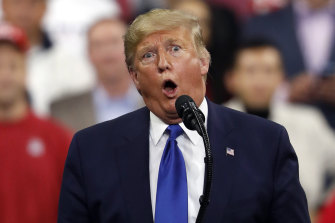US, China to sign a ‘big beautiful monster’ of a trade deal, Trump says
Washington: The US-China trade war is set to enter a quieter phase as President Donald Trump and Chinese Vice Premier Liu He sign an initial trade deal to vastly increase Chinese purchases of US manufactured products, agricultural goods, energy and services.
The Phase One agreement caps 18 months of tariff conflict between the world's two largest economies that has hit hundreds of billions of dollars in goods, roiling financial markets, uprooting supply chains and slowing global growth.
Trump and Liu are scheduled to sign the 86-page document on Wednesday at a White House event before over 200 invited guests from business, government and diplomatic circles.
President Donald Trump has been keen to portray the deal as a huge breakthrough.Credit:AP
A translation of the text to Chinese was still being completed late on Tuesday, as Liu met with US Trade Representative Robert Lighthizer.
Trump has already begun touting the trade deal as a centrepiece of his 2020 re-election campaign, calling it "a big beautiful monster" at a rally in Toledo, Ohio last week.
"Our farmers will take it in. I keep saying, 'Go buy larger tractors, go buy larger tractors,'" Trump said.
The centrepiece of the deal is a pledge by China to purchase an additional $US200 billion ($290 billion) worth of US goods over two years to cut a bilateral US trade deficit that peaked at $US420 billion in 2018.
A source briefed on the agreement told Reuters that China will purchase an additional $US80 billion worth of US manufactured goods over the two year period, including aircraft, autos and car parts, agricultural machinery and medical devices.
Beijing will boost energy purchases by some $US50 billion and services by $US35 billion, while agricultural purchases will get a $US32 billion lift over the two years, all compared to a 2017 baseline of US exports to China, the source said.
Although the deal could be a big boost to farmers, planemaker Boeing, US automakers and heavy equipment manufacturers, some analysts question China's ability to divert imports from other trading partners to the US.
The Phase One deal, reached in December, cancelled planned US tariffs on Chinese- made mobile phones, toys and laptop computers and halved the tariff rate to 7.5 per cent on about $US120 billion worth of other Chinese goods, including flat panel televisions, Bluetooth headphones and footwear.
China will spend more on US agriculture and energy.Credit:Bloomberg
But it will leave in place 25 per cent tariffs on a vast, $US250 billion array of Chinese industrial goods and components used by US manufacturers.
Evidence is mounting that these tariffs have raised input costs for US manufacturers, eroding their competitiveness.
Treasury Secretary Steven Mnuchin told reporters that Trump could consider easing tariffs if the world's two largest economies move quickly to seal a Phase Two follow-up agreement.
The deal includes pledges by China to forbid the forced transfer of American technology to Chinese firms as well as to increase protections for US intellectual property.
But it stops well short of addressing the core US complaints about China's trade and intellectual property practices that prompted the Trump administration to pressure Beijing for changes in early 2017.
The deal contains no provisions to rein in rampant subsidies for state-owned enterprises and fails to address digital trade restrictions and China's onerous cybersecurity regulations that have hobbled US technology firms in China.
Mnuchin and Lighthizer said these issues are key US priorities for Phase Two negotiations with China.
China has agreed in the Phase One deal to open its financial services sector more widely to US firms, and to refrain from deliberately pushing down its currency to gain a trade advantage, the latter prompting Treasury to drop its currency manipulator label on Beijing.
Reuters
Source: Read Full Article

